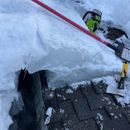Help prioritize ice dam fixes
I’m trying to mitigate severe ice dams on my 2 story home in Tahoe (Zone 6b), built in 1991.
Through reading this site and elsewhere I’ve become aware my house has multiple compounding problems. I need help prioritizing my fixes for the biggest impact for the least cost, and help with a couple of directional decisions to take.
Situation:
Dual forced air furnaces, with the furnace and ducts dedicated to the upstairs located in the attic. I’m not going to be able to relocate the attic furnace/ducts.
Attic has 868 sq.ft. of ‘floor area’.
Two 26×14 gable vents for ~700 sq.in of exhaust.
Twelve 1” diameter holes in groups of 3 drilled in 7 eves bays… minimal cold air intake.
Fiberglass batts on the attic floor.
Two exhaust chimneys for the two furnaces exit through the roof and keep 3′ diameter areas of the roof snow-free all winter despite 6-8’ of standing snow.
If it’s 30F outside and 70F inside, the attic is 50F. 🙁
So far I’ve converted all upstairs recessed cans to LED airtights, and covered most of them with Tenmat covers. I also vented outside the 2 bath vents that were exhausting to the attic. I added a gable fan but now realize without adequate intake I might be pulling air from my conditioned space (or it’ll pull from the north gable vent).
I think my next step is to add eave vents to get the sq.in. of intake more balanced with exhaust. However, even if I drill 3-4 larger 2” holes in every rafter bay I’ll only get 270-360 sq.in. of intake.
So my first question is: does each eave bay need venting? Or is it better to just tear out the 7 drilled bays and put in large 7.5×22” vents (for 800 sq.in. of intake)?
My larger question is, given my furnace and vents will always be in the attic, should I even bother with ventilation? Or should I try to move insulation to the roof deck? (maybe cost prohibitive!) Can I get to a semi-reasonable place (much smaller ice dams) through improved venting, basic sealing, and routing the exhaust chimneys to the roof edge when I re-roof in 3-5 years?
GBA Detail Library
A collection of one thousand construction details organized by climate and house part










Replies
I would absolutely add more soffit vents. Try to get up to a bit more intake area than you have outlet area. More cool air circulating through the attic will help mitigate other issues.
Next I would air seal all that ductwork in the attic very careful. Mastic on all the joints, and any other seams you can get to. Then insulate that duct better. You want to deal with ALL potential air leaks as a first step here. That's probably most of your problem right now -- too much indoor air leaking up into the attic and warming things up up there, resulting in the higher snow melting, running down the roof, and freezing into ice dams out at the eaves.
Last step would be to blow loose cellulose over the batts on the floor.
Bill
Thanks Bill.
ok, then I'll have to look at full vents. The bird holes aren't going to get me there!
I'll have to read up on duct insulation.
The first step is to keep the warm air in the house and out of the attic.
I think the only real way anyone can locate the leak is with a blower door type device.
This tedious work that must be preformed under difficult conditions finding someone willing to do a good job is no small feat.
You may want to take on the task yourself by duct taping a few box fans into a few windows and use the smoke from incense sticks to locate the air leaks and caulk the gaps. My guess is you will find all the recessed light are still leaking. Them turn on the blower for the furnace and go over every joint in the duct work with the smoke and fix the leaks with foil tape. Only after all the air leaks are stopped can you work on the insulation and attic ventilation.
Did you find a way to vent the bath fans outdoors?
Walta
Walta, for the bath fans I ran insulated ducting from both and joined them both with a 'Y' that has one-way butterfly valves, and exited that out the eave.
Finding good help up in Tahoe is a challenge. I'll have to see if I can find someone to help... maybe they do the duct work that Bill is referring to.
What you want to do first is find a local tech that has a duct blaster. This will pressurize the ducting and can be used to see where air leaks are and seal it up. I would not be surprised that sealing up your ducting and air handler will resolve most of your ice issues.
You'll also have to do something about your furnace vents, those should not be melting the snow. If you have older non-power vented units, it might be time to swap it out for high efficiency power vented unit with plastic vent pipes. These can also be vented through the gable end which avoids any roof snow melt issues.